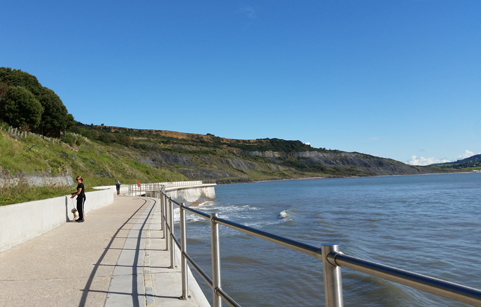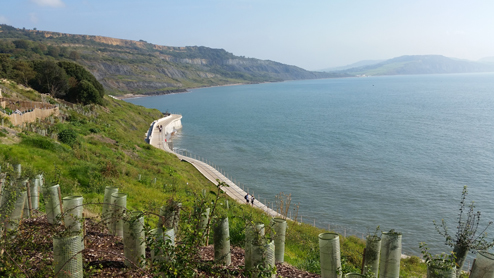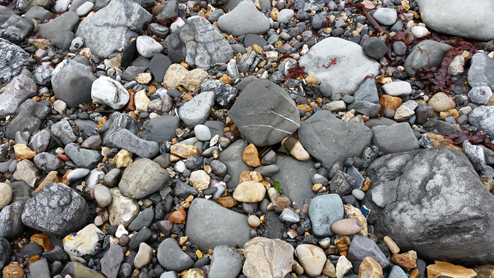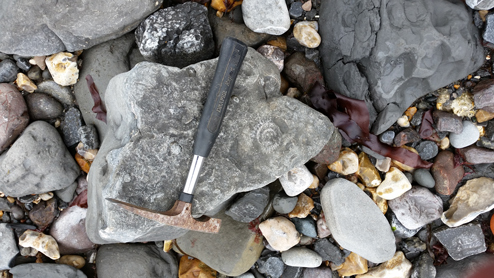Notes on Lyme Regis Fossil Walks Provide Excellent Value
A Private Fossil Walk Represents Good Value
With the completion of the eastern sea wall at Lyme Regis last year the access to the beach between the town and Charmouth has certainly got easier. No more climbing over the slippery rocks and the groynes that laid between the end of the beach front and the Church Cliffs. That might sound like good news and it certainly is, especially for families trying to access the beach. There is a downside to the new sea defences though, greater access has meant that over the summer months there have been more people than ever scouring the beach between Charmouth and Lyme Regis looking for fossils. Pickings can be somewhat slim as a result.
Charmouth and Lyme Regis
The Newly Completed Magnificent Sea Wall at Lyme Regis
Picture credit: Everything Dinosaur
Visit Everything Dinosaur’s website: Everything Dinosaur.
Sea Defences
The sea wall is part of an extensive array of features to help secure the cliffs and the land immediately behind them in a bid to protect the area from further land slips. Eventually, these defences will give way but the engineering works has probably given the many houses on the cliffs another fifty years of life or so.
Whether or not the sea wall and other defences such as the remodelled beach area close to the famous Cobb has had an impact on the way in which the waves scour the beaches remains uncertain, time will tell, although we have heard from one reliable source that there seems to be a greater amount of sediment deposited out into Lyme Bay. To help stabilise the cliffs, the slopes have been planted with thousands of small bushes and other plants to help anchor the soil.
The Cliffs have been Planted to Help Prevent Further Land Slides
Picture credit: Everything Dinosaur
What Do the Changes Mean for Fossil Hunters?
Lyme Regis has always been a popular destination for would-be fossil hunters. With easier access to the beaches to the east of the town, there is a feeling amongst locals that finding fossils along the shoreline is getting harder.
There are certainly lots of fossils to be found, but large pieces of ammonite and any ichthyosaur vertebrae are increasingly rare. For example, during a recent trip to Lyme Regis, we spent a morning on the beach walking slowly up to Charmouth and we were surprised by the lack of fossils. Belemnite guards were still plentiful, especially as we approached the “Belemnite Beds” but we found no fossils of Promicroceras, which surprised us somewhat.
This small ammonite used to be a relatively common fossil find, there was also a lack of nodules on the beach, although from the scattered shards of split rock there was plenty of evidence of previous visitors having hammered away quite happily at any stone bigger than a house brick, whether or not it was likely to contain a specimen inside.
Not a Very Successful Fossil Hunt
Picture credit: Everything Dinosaur
Advice for Visitors to Lyme Regis
With the popularity of fossil collecting on the increase and with the easier access to the beach, visitors to Lyme Regis might be disappointed by their lack of fossil discoveries. One way of helping to get the most out of a visit is to book yourself onto an organised public walk. There are a number of professional fossil hunters and guides who offer public walks. These are a very good idea, especially when one considers the risk of getting cut off by an incoming tide or the hazards of rocks falling from the cliffs.
On a public walk your knowledgeable guide should be able to provide you with a very informative tour of the geology and help you to find a few fossils along the way.
Private Fossil Walks are Best
However, if you really want to make the best use of your time, try booking a private walk. On some public walks that we have observed there can be as many as fifty people in the party. Simply, getting a question answered amongst a throng of eager fossil hunters that size can be quite an ordeal, even the most dedicated guide can struggle to accommodate everybody’s needs. Public walks tend to take place on the weekend, a time when the beaches are likely to be congested. Private walks can be booked at a time to suit you (tides permitting) and you can be assured that your party will be very well looked after by the guide.
You are also more likely to be directed to the best fossil hunting locations, local knowledge wins out every time. For example, for that beautiful Promicroceras ammonite, your best chance might be to sieve for fossils. On a private walk, the guide can provide suitable sieves and show you the best technique to help you make your very own fossil discovery. Knowing exactly where to start sieving on the beach is half the battle.
Still Fossils to be Found but Local Knowledge is Key
Picture credit: Everything Dinosaur
Private walks book up very quickly in advance, if you are thinking of visiting the Dorset coast next year, now is an ideal time to get yourself and your family booked on one. Fossil walks are arranged around safe tide times so be aware that some preferred days may not be suitable. Most organisers of private fossil walks ask for children to be at least five years old.
Guided Fossil Walks
Walks take around three to four hours, advice can be provided on where to park any vehicles and as for what you should bring here is a quick check list:
- Suitable clothing, wellington boots or other stout footwear. Warm clothing especially in the winter and early spring, having a waterproof jacket on hand is very sensible, gloves in cold weather too.
- Bring a snack and a drink although remember to take your rubbish home with you.
- Bathroom breaks – there are no toilet facilities on the beaches, although most walks commence from the town centre and there are toilet facilities here at the start of the walk.
- Tools to bring – most guides will be happy to break any nodules open for you, hammers are not usually supplied. If you do bring your own hammer (please make sure it is a geological hammer), then remember the safety specs and tough gardening gloves. For advice on the difference between geological hammers and tool box hammers: Geological Hammers What’s So Special About Them?
Finding Fossils
The fossil walk guide will be able to provide you with the very best chance of finding a top quality fossil and also be able to point out the best places to look. You will learn a lot more about the history of the local area as well as having the opportunity to get one to one assistance and support. Private fossil walks really do offer excellent value and they usually cost less than a family three-course meal in a pub.
For further information on private walks (public walks as well), Everything Dinosaur recommends: Lyme Regis Fossil Walks.
Private fossil hunting walks at Lyme Regis can prove to be a very worthwhile investment and provide visitors to the Jurassic Coast with an excellent opportunity to learn more about this fascinating area of Britain.





